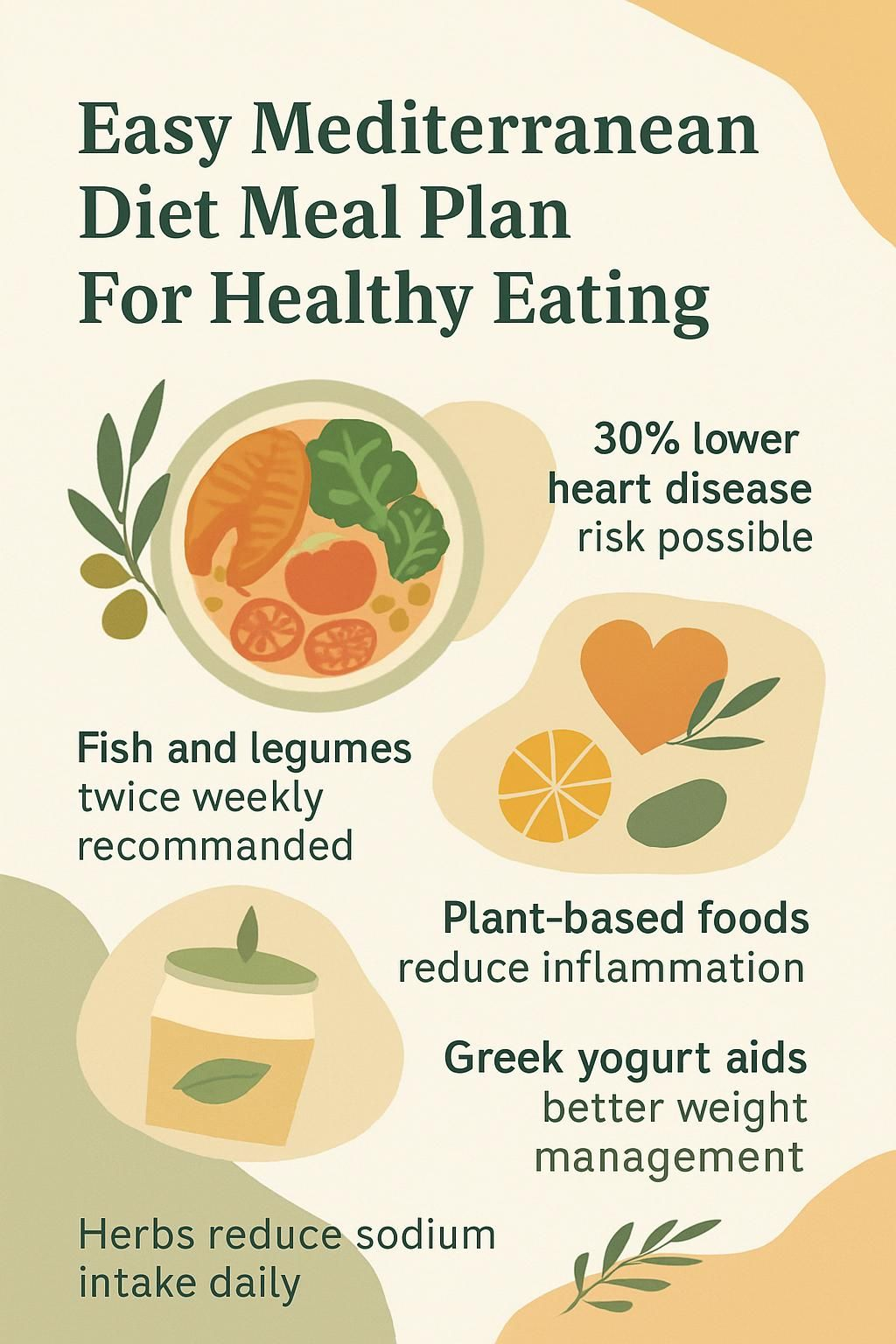Easy Mediterranean Diet Meal Plan For Healthy Eating
Our Nutrition Assistant AI Suite will transform your body. You will lose fat, get toned, and build muscle. Gain confidence and optimal health.
Trying to eat healthier can feel confusing with so many plans online. I felt stuck too, until I explored a simple Mediterranean diet meal plan that fit my schedule.
The Mayo Clinic ranks this way of eating as a top choice for heart health. I reviewed guidance from sources like the American Heart Association and built an easy plan that works on busy days.
In this guide, you will see a clear food list, practical tips, quick facts, and a realistic 7-day Mediterranean meal plan for meals and snacks. You can enjoy great taste while building healthy habits, one plate at a time.
Key Takeaways
- The Mediterranean Diet focuses on whole grains, olive oil, vegetables, fruit, and lean proteins. A large NEJM trial reported about 30% fewer major heart events for followers.
- The American Heart Association encourages replacing red meat with fish and legumes at least twice a week for heart health.
- Plant foods rich in antioxidants, like tomatoes, leafy greens, beans, and nuts, help reduce inflammation and lower type 2 diabetes risk.
- Planning with staples such as Greek yogurt, chickpeas, fruit, salmon, and extra virgin olive oil supports better weight control than many low-fat diets.
- Using herbs instead of salt cuts sodium while keeping flavor high. A written shopping list improves your odds of sticking to healthy choices.

What is the Mediterranean Diet?

The Mediterranean Diet reflects how people eat in countries along the Mediterranean Sea. It centers on whole grains, olive oil, vegetables, fruit, legumes, nuts, and seafood, with small amounts of dairy and poultry.
What foods are included in the Mediterranean Diet?
This pattern highlights real, whole ingredients that deliver flavor and steady energy. Most meals lean on plants, healthy fats, and lean proteins.
- Vegetables and fruits: I rotate tomatoes, peppers, spinach, apples, and citrus to cover many nutrients.
- Whole grains: I choose whole grain bread, brown rice, oats, barley, couscous, and quinoa for fiber and stable blood sugar.
- Legumes and beans: Lentils, chickpeas, and black beans supply protein and fiber that support gut health.
- Healthy fats: Olive oil is my main fat for cooking and dressings. I also enjoy olives, avocado, nuts, and seeds.
- Lean proteins: Fish like salmon or sardines bring omega-3 fatty acids that support heart health. I aim for fish twice a week.
- Dairy products: Moderate servings of Greek yogurt or cottage cheese add calcium with less saturated fat than cream or butter.
- Herbs and spices: Basil, oregano, chili flakes, garlic, cumin, and black pepper boost flavor without extra sodium or sugar.
- Poultry and eggs: Chicken breast and eggs offer flexible lean protein with less saturated fat than red meat.
- Limited red meat: I keep portions small and infrequent because high intake links to higher heart disease risk.
- Minimal processed foods: I skip refined snacks and added sugar. Choosing natural options improves nutrition and fullness.
This approach keeps my plate colorful and supports lower risks for cardiovascular disease and type 2 diabetes.
What are the key principles of the Mediterranean Diet?
The core is simple. Fill most of your plate with plants, choose olive oil as your main fat, and enjoy fish often. Use nuts and seeds in place of processed snacks. Flavor food with herbs and spices instead of salt.
Meals are social too. I eat slowly with family or friends when I can, which keeps this healthy diet enjoyable. A small glass of red wine at dinner can be part of the pattern for some adults, but it is optional.
These principles make healthy eating feel natural and pleasant over time.
Next up, I will share how this pattern supports your body with meaningful health benefits.
What are the health benefits of the Mediterranean Diet?
Following a Mediterranean meal plan can help lower the risk of heart disease, diabetes, and some cancers. It supports a healthy weight, better blood sugar, and brain health due to nutrient-dense, plant-forward foods.
How does it support heart health?
Olive oil, nuts, and fish provide unsaturated fats that can lower LDL, the “bad” cholesterol. Lower LDL means less plaque buildup in arteries, a key step for heart protection.
Studies show this eating pattern can reduce blood pressure and chronic inflammation, both major heart risks. A large trial in The New England Journal of Medicine reported up to 30 percent fewer major cardiovascular events among participants who followed a Mediterranean-style diet.
I pack my meals with antioxidants from leafy greens, tomatoes, beans, and whole grains. These nutrients fight oxidative stress, which is linked to stroke and heart problems.
How does it reduce the risk of chronic diseases?
Whole grains, greens, legumes, nuts, and olive oil form a strong base against chronic disease. These foods are rich in fiber and antioxidants that calm inflammation and support a healthy gut microbiota, the friendly bacteria in your digestive tract.
Research in Nutrients shows lower rates of metabolic syndrome and cardiovascular disease among people who follow this pattern. I noticed more steady energy after I swapped refined carbs for whole grains and beans at lunch and dinner.
Can it help with weight management?
Yes. This way of eating favors fiber-rich foods and healthy fats that keep me full. That often means fewer calories without feeling deprived.
In a 2013 NEJM study, people following a Mediterranean meal plan lost more weight than those on a low-fat diet. Meals like Greek salad with chickpeas, or roasted sweet potato with herbs, help me stay satisfied between meals.
How does it improve brain health?
Healthy fats from olive oil and nuts support brain cell membranes, which helps memory and thinking. Eating more vegetables, fish, and whole grains links to slower cognitive decline.
Harvard researchers report that Mediterranean-style eating may reduce dementia risk. The 2020-2025 Dietary Guidelines for Americans also encourage more plant foods because antioxidants and anti-inflammatory compounds support long-term brain health.
How to build a Mediterranean Diet meal plan
I start with fresh ingredients and simple cooking methods. That keeps meals realistic for weekdays and sets me up for success.
Why focus on whole, plant-based foods?
Leafy greens, beans, and nuts supply fiber, vitamins, and minerals that support heart health and steady blood sugar. Fiber also feeds good gut bacteria, which supports digestion and immunity.
Evidence from the PREDIMED trial showed that higher intake of fruits, whole grains, and vegetables linked to fewer cardiovascular events. I often choose lentil soup or grilled vegetable salads during meal prep. Those choices keep me full longer and give me even energy.
How to incorporate healthy fats like olive oil?
Olive oil is my daily cooking and dressing fat. I drizzle extra virgin olive oil on salads and steamed vegetables to improve flavor and nutrient absorption.
People in Mediterranean regions who eat plenty of olive oil tend to have lower rates of heart disease than those on Western diets[1]. For cooking, I swap butter for olive oil when sautéing leafy vegetables, grilling seafood, or roasting almonds.
Olive oil is rich in monounsaturated fat, which can lower LDL when it replaces saturated fat, according to the American Heart Association[2]. On Day 1 or Day 3, I might add a tablespoon to roasted chickpeas or grilled chicken. Keeping a bottle handy helps me use it often in my meal plan.
…
[1] “Mediterranean diet lowers risk for heart disease,” Harvard School of Public Health
[2] “Dietary Fats and Cardiovascular Disease,” American Heart Association
What lean proteins and seafood should I include?
Lean proteins and seafood are key parts of this plan. They replace red and processed meats and add variety.
- Skinless poultry, like chicken or turkey, several times a week for lean protein.
- Fatty fish such as salmon, tuna, sardines, or mackerel at least twice weekly for heart support.
- Shellfish, including shrimp, crab, and mussels, for protein plus zinc and vitamin B12.
- Plant proteins, like lentils, chickpeas, beans, or tofu, to match the plant focus of this diet.
- Low-fat dairy in moderate portions, such as plain Greek yogurt or part-skim cheese.
- Red meat only a few times per month, replaced by legumes or fish in most meals.
- Cook proteins with olive oil and herbs instead of frying or heavy sauces.
Why minimize processed and sugary foods?
Processed and sugary foods spike blood sugar and add empty calories. Frequent spikes raise risks for type 2 diabetes and heart issues, and they make weight control harder.
I switched to fruit or nuts instead of packaged snacks. My energy felt steadier and cravings dropped. Processed foods also tend to include unhealthy fats and excess sodium, which can raise cholesterol and blood pressure.
Choosing whole foods supports a healthy lifestyle and matches how people eat on the Mediterranean Diet. The food tastes better too, which helps me stick with it.
Core components of a Mediterranean Diet meal plan
This way of eating is simple and flexible. Each easy meal can highlight fresh, seasonal ingredients that fit your taste and budget.
What whole grains and legumes are recommended?
Whole grains and legumes are workhorses in this plan. They support heart health and weight management.
- Whole wheat bread is a daily staple for me.
- Brown rice makes a filling base and has more fiber than white rice.
- Oats are an easy breakfast or a smart baking ingredient.
- Barley adds texture to soups and salads and may help lower cholesterol.
- Farro, an ancient grain, delivers a nutty taste and solid protein.
- Chickpeas are a top plant protein for salads and hummus.
- Lentils cook fast, bring iron, and fit well in soups or bowls.
- Black beans add fiber and can stand in for meat in wraps or stews.
- Cannellini beans have a mild taste that blends with tomatoes and leafy greens.
These staples make budget-friendly, satisfying meals throughout the week.
Which fresh fruits and vegetables are best?
After choosing grains and legumes, I load my cart with produce. Aim for color and variety every day.
- Tomatoes and bell peppers offer vitamin C, fiber, and antioxidants for heart health.
- Leafy greens like spinach, kale, and arugula provide iron and folate for strong blood.
- Cucumbers add crunch and hydration with few calories.
- Berries, such as strawberries and blueberries, deliver antioxidants that support brain health.
- Citrus fruits, including oranges and lemons, supply vitamin C and brighten meals.
- Grapes contain polyphenols that support flexible arteries.
- Eggplant and zucchini work in salads or cooked dishes and bring potassium.
- Apples and pears offer natural sweetness and fiber for gut health.
- Carrots add color plus beta carotene, a nutrient important for eye health, raw or roasted.
- Seasonal produce often tastes better and may carry more nutrients.
Fresh staples like these keep meals varied, nutrient-dense, and enjoyable.
What seafood and lean proteins fit the diet?
Seafood and lean proteins make this plan satisfying without heavy sauces or excess saturated fat.
- Salmon provides omega-3 fats that support brain and heart health. I like it grilled with herbs.
- Sardines, mackerel, or trout offer protein and healthy fats. I include them twice a week.
- Skinless chicken or turkey gives lean protein. I toss grilled strips into lunch salads.
- Shellfish like shrimp or scallops are low in calories and high in nutrients.
- Eggs bring complete protein. I boil a few for quick snacks on busy days.
- Tuna, especially canned in water, is an easy pantry protein for bean salads.
- Legumes, including lentils and chickpeas, deliver plant protein and fiber.
- Lean red meat in small amounts can fit. I choose extra-lean cuts and whole grain buns for burgers.
- Greek yogurt provides protein and probiotics for breakfast or snacks.
Rotating these options keeps meals interesting while staying close to Mediterranean guidelines.
Which nuts, seeds, and healthy fats should I eat?
Nuts, seeds, and olive oil bring flavor and staying power to meals.
- Enjoy a small handful of almonds or walnuts several times a week.
- Add chia or flaxseeds to oatmeal, yogurt, or salads for fiber and omega-3s.
- Cook mostly with olive oil. It supports healthier cholesterol levels.
- Top bowls with sunflower or pumpkin seeds for crunch and minerals.
- Snack on pistachios instead of chips for protein and antioxidants.
- Add avocado to salads or sandwiches for creamy texture and healthy fat.
- Use tahini, a sesame paste, in dressings or spreads for plant-based fat and calcium.
These choices are simple swaps that raise flavor, satisfaction, and nutrient quality.
How can herbs and spices add flavor?
Herbs and spices lift flavor without extra calories or salt. I often use basil, oregano, and rosemary in sauces for freshness.
Cumin and coriander add warmth to lentil soups or grilled fish. AHA research suggests herb-based seasoning can lower sodium intake while keeping meals tasty.
A little cinnamon perks up oatmeal. Paprika on lean turkey burgers adds color and depth. Small changes like these keep weekly menus exciting.
Sample 7-day Mediterranean Diet meal plan
This sample 7-day plan shows a balanced menu with produce, whole grains, lean proteins, and healthy fats. Mix and match meals to fit your taste and routine.
What are good options for Day 1 meals and snacks?
I start with fast, fresh choices that keep me full and energized.
- Breakfast: Greek yogurt with strawberries and a small drizzle of honey, about 15 grams of protein.
- Snack: A handful of raw almonds for healthy fats and crunch.
- Lunch: Whole grain pita with hummus, roasted red peppers, cucumber, and spinach.
- Snack: Caprese-style tomatoes with mozzarella, basil, olive oil, and black pepper.
- Dinner: Grilled salmon over quinoa with cherry tomatoes, spinach, feta, lemon, and olive oil.
- Snack: Roasted chickpeas with paprika or cumin for fiber and protein.
- Drinks: Water or unsweetened herbal tea for hydration.
Then I bring in new flavors for Day 2.
What can I eat on Day 2 for breakfast, lunch, dinner, and snacks?
Keep breakfast simple, then build color through the day.
- Breakfast: Greek yogurt with sliced strawberries, chia seeds, and a few walnuts.
- Snack: An apple with a few raw almonds.
- Lunch: Quinoa salad with cherry tomatoes, cucumber, chickpeas, red onion, parsley, olive oil, and lemon.
- Snack: Carrot sticks or bell pepper strips with hummus.
- Dinner: Grilled salmon with roasted zucchini and eggplant tossed in olive oil.
- Snack: Melon cubes or orange slices for a light dessert.
Here are more ideas to keep the week varied.
What meals are suggested for Day 3?
Day 3 stays simple and tasty with fresh ingredients.
- Breakfast: Greek yogurt with strawberries and a drizzle of honey. Add chia for extra fiber.
- Snack: Whole grain toast topped with smashed avocado, diced tomatoes, and black pepper.
- Lunch: Big salad with spinach, cherry tomatoes, cucumber, olives, feta, olive oil, and grilled chicken breast.
- Snack: A small handful of walnuts or almonds.
- Dinner: Baked cod with lemon, garlic, parsley, and pepper. Serve with roasted bell peppers and quinoa.
- Dessert: Orange slices or apple wedges if you want something sweet.
Next are healthy choices for Day 4.
What is a healthy meal plan for Day 4?
Fresh flavors and easy prep keep Day 4 on track.
- Breakfast: Greek yogurt, strawberries, and a sprinkle of chia seeds for protein and fiber.
- Snack: A small apple with a handful of raw almonds.
- Lunch: Whole grain pita with hummus, spinach, cucumber, and tomatoes, plus optional feta.
- Snack: Carrot sticks with tzatziki for fiber and a creamy dip.
- Dinner: Grilled salmon over quinoa pilaf with bell peppers and parsley. Finish with a light olive oil drizzle.
- Dessert: Orange segments topped with chopped walnuts.
- Hydration: Water or unsweetened herbal tea throughout the day.
Each item reflects the core of this plan: plants first, lean proteins, whole grains, and healthy fats.
What should I eat on Day 5?
Day 5 keeps meals balanced, fast, and flavorful.
- Breakfast: Greek yogurt with chia seeds, walnuts, and strawberries.
- Snack: A small apple with raw almonds.
- Lunch: Mixed greens with tomatoes, cucumber, chickpeas, olives, feta, and extra virgin olive oil.
- Snack: Carrot sticks or bell pepper strips with hummus.
- Dinner: Grilled salmon with quinoa cooked in low-sodium vegetable broth and steamed broccoli.
- Dessert: Fresh orange slices or a few dried apricots.
- Drinks: Water, flavored with lemon or mint if you like.
On to Day 6 for more variety.
What are meal ideas for Day 6?
Day 6 highlights color, texture, and healthy fats in each dish.
- Breakfast: Low-fat Greek yogurt, strawberries, chopped walnuts, and a drizzle of honey.
- Snack: A small apple and ten almonds.
- Lunch: Quinoa salad with tomatoes, cucumbers, chickpeas, lemon, olive oil, and parsley.
- Snack: Carrot sticks with homemade hummus from chickpeas, garlic, tahini, and lemon.
- Dinner: Grilled salmon over sautéed spinach with brown rice on the side.
- Snack: Mixed berries topped with a few sunflower seeds.
These meals combine whole grains, lean proteins, and plenty of produce, plus olive oil and nuts.
What meals and snacks are included on Day 7?
Day 7 wraps up the week with simple, heart-healthy options.
- Breakfast: Greek yogurt with strawberries, chopped walnuts, and a light drizzle of olive oil.
- Snack: A small apple or pear with a handful of unsalted almonds.
- Lunch: Mixed greens with tomatoes, chickpeas, grilled chicken or tofu, cucumber, and lemon-olive oil vinaigrette.
- Snack: Carrot sticks with hummus made from chickpeas, tahini, olive oil, garlic, and lemon.
- Dinner: Baked salmon with dill and garlic, plus sautéed spinach and brown rice pilaf.
- Snack: Mixed berries or grapes sprinkled with roasted sunflower seeds.
Next you will find shopping and prep tips that make this plan easy to follow.
Tips for grocery shopping and meal prep
Smart shopping and simple meal prep help me stay consistent. These steps save time and cut stress during the week.
How do I create an effective shopping list?
I start with a weekly plan and list every ingredient for each recipe. I group items by category, like produce, grains, seafood, lean proteins, nuts, and olive oil. This cuts wandering and helps me skip impulse buys.
I also check my pantry and fridge before shopping to avoid duplicates. The American Heart Association notes that planning ahead supports better choices. A clear list keeps my meals balanced all week.
What pantry staples should I stock up on?
Stocking the right staples makes healthy cooking quick and reliable.
- Extra virgin olive oil for dressings and cooking.
- Canned chickpeas and lentils to save time and add fiber.
- Whole grain pasta, brown rice, or farro for steady energy.
- Unsalted nuts like almonds or walnuts for snacks or salads.
- Dried herbs and spices, including oregano, basil, cumin, and paprika, for bold flavor without extra salt.
- Canned tomatoes and tomato paste for fast soups and sauces.
- Tuna or salmon packed in water for quick protein.
- Jarred olives for healthy fats and a tangy punch.
- Greek yogurt for protein and calcium at breakfast or snack time.
- Quinoa for speedy, balanced bowls with vegetables or seafood.
How can I plan meals ahead of time?
I set aside 30 minutes to pick recipes, write a shopping list, and check my staples. This reduces waste and limits last-minute takeout.
I batch-cook grain salads, roasted vegetables, and lean proteins, then portion them into containers. Research in the American Journal of Preventive Medicine links home-prepared meals with better diet quality and lower calorie intake. Planning once helps me stay on track all week.
How to adapt the Mediterranean Diet to your lifestyle
You can personalize this plan to match your taste, culture, and schedule. I test small changes, then keep the ones that stick.
What are vegetarian and vegan options?
Plant-forward eating fits naturally into this meal plan.
- Swap beans or lentils for meat in stews and salads for protein and fiber.
- Use tofu or tempeh, grilled or sautéed with oregano, basil, and thyme.
- Add chickpeas to stir-fries or blend them into hummus for a creamy dip.
- Build grain bowls with quinoa, farro, bulgur, or brown rice, plus roasted veggies and olive oil.
- Include almonds, walnuts, and pistachios for healthy fats and crunch.
- Snack on fresh fruit like figs or oranges with unsweetened plant yogurt.
- Rely on seasonal vegetables, including tomatoes, eggplants, peppers, spinach, and kale.
How can I make gluten-free adjustments?
These swaps keep the plan safe for celiac disease or gluten sensitivity while preserving nutrition.
- Choose certified gluten-free grains like quinoa, buckwheat, millet, or brown rice.
- Read labels for hidden gluten, such as modified food starch or malt flavoring.
- Use chickpeas, lentils, and other legumes as satisfying stand-ins for bread or pasta.
- Pick almond flour, coconut flour, or certified gluten-free oat or corn flours for baking.
- Ask about ingredients at restaurants to avoid accidental exposure.
- Keep nuts and seeds on hand for naturally gluten-free snacks.
- Use extra virgin olive oil in place of dressings that may contain gluten-based thickeners.
How to plan Mediterranean meals on a budget?
I focus on budget-friendly staples like beans, lentils, brown rice, and seasonal vegetables. Canned tuna or sardines provide lean protein for less. I buy olive oil in bulk to cut the cost per ounce.
Frozen vegetables are reliable when fresh produce costs more. Local markets can offer better prices and fresher items. I batch-cook soups and grain salads to reduce waste and save time later. Garlic, dried herbs, and lemon deliver big flavor for a small price. Weekly store flyers help me plan around deals on nuts or yogurt.
Plant-based Mediterranean choices help me feel energized while keeping costs under control.
Common questions about the Mediterranean Diet
Many people share the same questions. Here are clear answers to help you start with confidence.
Can I drink wine on the Mediterranean Diet?
A small glass of red wine with dinner can fit this plan for most healthy adults. Guidance suggests up to one drink per day for women and up to two for men. Wine contains antioxidants such as resveratrol that may support heart health.
I enjoy a small glass a few nights a week with food, which helps me slow down. If you avoid alcohol or take medicines that interact with it, choose water or tea instead.
Are dairy products allowed?
Yes. Greek yogurt and cheeses like feta appear in many traditional dishes. Fermented dairy can provide probiotics, which may support gut health and digestion.
I use low-fat Greek yogurt for snacks or sauces to keep saturated fat in check. Up to two daily servings of dairy can fit many Mediterranean meal plans while supporting bone health.
What foods should I avoid?
I limit foods that are highly processed or heavy in sugar, sodium, or unhealthy fats.
- Processed meats like hot dogs, salami, bacon, and sausage are high in sodium and saturated fat.
- Refined grains, such as white bread, regular pasta, and white rice, lack fiber and key nutrients.
- Sugary drinks, including soda and sweet tea, add lots of sugar without nutrition.
- Packaged snacks like chips and candy often include trans fats and additives.
- Sweets such as cakes, pastries, doughnuts, and ice cream raise sugar intake quickly.
- Margarine sticks or spreads with hydrogenated oils may raise LDL cholesterol.
- Fast food combos are usually high in calories, sodium, and unhealthy oils.
These guidelines help me stay close to the core principles of a Mediterranean Diet meal plan.
Practical lifestyle tips beyond diet
Healthy habits support the diet and make it easier to maintain. Small changes add up over months and years.
Why is staying active important?
Regular movement improves heart health and lowers chronic disease risk. It also supports weight control, mood, and sleep.
The American Heart Association recommends at least 150 minutes of moderate exercise each week. Simple activities count. I walk after dinner or do light strength work at home, which keeps me consistent.
How can sharing meals improve my experience?
Sharing meals helps me slow down and feel satisfied. Talking with others can reduce stress and loneliness, which supports mental health.
Eating with family or friends also nudges healthier choices. Planning menus together makes it easier to stick with vegetables, whole grains, and seafood.
What are mindful eating practices?
Mindful eating means paying attention to the look, texture, and taste of food. I put my phone away, chew well, and stop eating when I feel comfortably full.
These habits aid digestion and help me enjoy every bite of olive oil, tomatoes, or warm whole grain bread. Research suggests mindful eaters overeat less and enjoy food more[1].
This skill pairs well with the Mediterranean meal plan. It turns routine meals into a calm daily practice.
Conclusion
Choosing a Mediterranean diet meal plan supports healthy eating with real, accessible foods. Evidence shows this pattern can lower heart disease risk and support brain health over time[1].
Simple recipes with olive oil, leafy greens, seafood, legumes, and whole grains make meals both tasty and nourishing. With smart shopping, light prep, and steady habits, better health can fit your daily routine.
This information is educational and not medical advice. If you have a health condition, speak with a registered dietitian or your clinician before changing your diet.
…
[1] Estruch R et al., “Primary Prevention of Cardiovascular Disease with a Mediterranean Diet,” The New England Journal of Medicine (2013).
FAQs
1. What is an easy Mediterranean diet meal plan for healthy eating?
An easy Mediterranean diet meal plan includes whole grains, fresh vegetables, fruits, beans, olive oil, and lean proteins such as fish or poultry. Studies show this approach supports heart health and weight control (Harvard T.H. Chan School of Public Health).
2. How does the Mediterranean diet support healthy eating?
The Mediterranean diet emphasizes nutrient-rich foods that provide fiber, vitamins, minerals, and antioxidants. Research links this pattern to lower risks of heart disease and diabetes (New England Journal of Medicine). For example, a typical day may include oatmeal with berries for breakfast; salad with chickpeas at lunch; grilled salmon with roasted vegetables for dinner.
3. Can I follow a simple Mediterranean meal plan on a budget?
Yes; many staple foods like lentils, brown rice, canned tuna in water, seasonal produce such as spinach or apples are affordable options within the Mediterranean diet framework. My own experience using weekly grocery lists helped me save money while preparing balanced meals.
4. What are some key tips for starting an easy Mediterranean meal plan?
Begin by planning meals around plant-based ingredients like beans or leafy greens; use olive oil instead of butter; add herbs for flavor rather than salt; choose fruit over sweets for dessert. These steps help build lasting habits that promote better nutrition.
Summary: The Mediterranean diet focuses on whole foods rich in nutrients and flavor while supporting long-term health goals through evidence-based choices and practical strategies adaptable to daily life.







